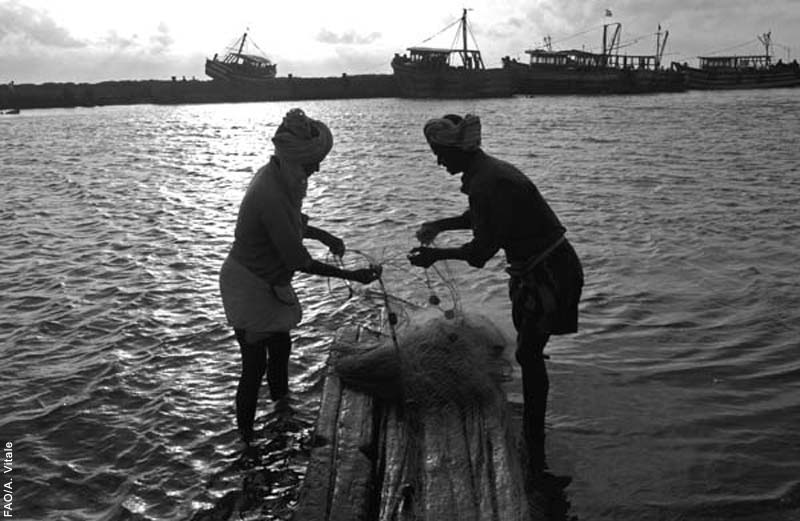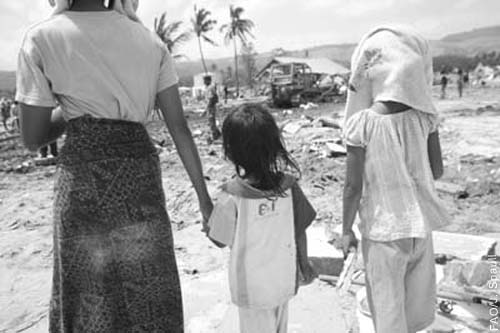
OVERVIEW
The Rome-based agencies all responded immediately to the unprecedented challenge of the Asian tsunami of December 2004. Within days, WFP had moved thousands of tons of food aid to the tsunami zone to avert large-scale hunger. WFP's efforts now are transitioning to rehabilitation and recovery, focusing on providing assistance to vulnerable populations such as displaced people, mothers and children. Meanwhile, FAO is helping the governments and communities of tsunami-affected countries in planning the rehabilitation of the agriculture, fisheries and forestry sectors. FAO's role is to coordinate and provide technical assistance and policy guidance for all of these sectors, together with the provision of direct assistance. IFAD has been mobilising funds to rebuild livelihoods and build capacity in coastal communities. The efforts, while separate, have been complementary, and the scope for cooperation is growing as the emergency phase ends and long-term recovery and reconstruction pick up steam.
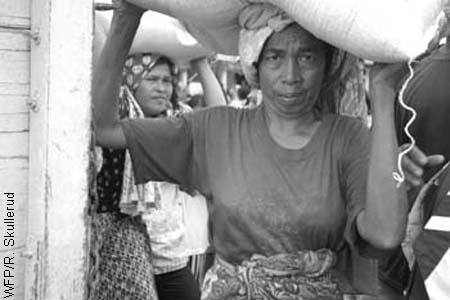
| WFP/FAO cooperation in Indonesia |
| In Indonesia, WFP and FAO regularly cooperate to produce Crop and Food Supply Assessments. The latest was produced in March. For WFP, this assessment helped refine the target criteria for food assistance. |
| Discussions are also underway to set up a Food, Livelihood and Nutrition Surveillance System under which WFP and FAO would cooperate to provide technical backup to the Indonesian ministries of Health and Agriculture. The surveillance system will be designed to monitor the health and nutritional status of the population in order to identify high-risk groups, design appropriate interventions and determine the impact of these interventions. It is hoped the system will begin operations in July. |
WFP
The World Food Programme launched a massive and immediate response to the 26 December Indian Ocean tsunami. Ships were diverted, personnel moved to the region and a major airlift began to bring food to the survivors. Within days, helicopters were continuously ferrying WFP food down Sumatra's remote western coast, the hardest hit area in the region. In Sri Lanka, WFP was feeding 750,000 people by January 7.
The relief effort required one of the most complex logistical operations in WFP's history. Supply routes were opened to areas of Indonesia where roads had been washed away by using “floating warehouses” and landing craft. By the end of January, operations involved 6 fixed-wing aircraft, 8 dedicated helicopters, and over 200 trucks. A critical factor was the massive response by WFP's standby partners and WFP staff - 328 of whom came to work on the operation from points around the world. Over 250 additional personnel were recruited locally. By the end of May, WFP had delivered food aid to 2.24 million people across the region.
Operations are now well into the transition from relief to recovery, with a focus on targeting vulnerable populations. School feeding is reaching thousands of students in Sri Lanka and Indonesia, and programmes to support pregnant women, mothers and infants have begun. In the Maldives, aid will continue for families who have lost their livelihoods while food assistance targeted to women continues in affected areas of Somalia. WFP's assistance to affected areas of Thailand and Myanmar has now wrapped up. At the time of writing, WFP was providing food to over 1.5 million people in the tsunami zone, and had dispatched over 130,000 metric tons of food.
WFP assistance will continue to tsunami-hit areas of Indonesia and Sri Lanka through 2006 and 2007 as Protracted Relief and Recovery Operations (PRROs). In Sri Lanka, the protracted operation will cover approximately 1 million people and include assistance to mothers and infants, school feeding, Food for Work programmes, and food aid to displaced populations. In Indonesia, approximately 850,000 people will receive general rations and another 1,275 million will receive supplementary rations. Programmes will include school feeding, Food for Work, capacity building, mother and child health projects, and assistance to displaced populations until their homes and livelihoods are rebuilt.
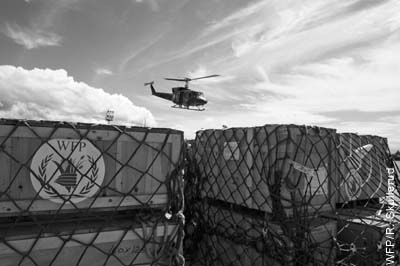
FAO
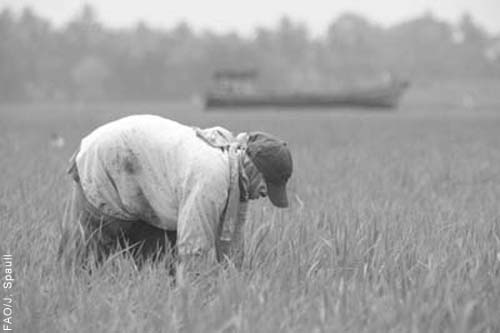
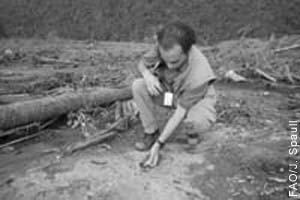
The Food and Agriculture Organization is focused on “building back better” the livelihoods of those hardest hit by the tsunami. FAO is currently delivering a US$56 million assistance programme in affected countries, with a further US$25 million in the pipeline.
More than 70 international and regional experts have been deployed to help affected countries with needs assessments, coordination, planning and delivery of early recovery and longer-term reconstruction assistance. In Indonesia, for example, FAO supported the Ministry of Marine Affairs and Fisheries and the Ministry of Agriculture in the finalization of sectoral programme strategies in Aceh and Nias.
To enable resumption of income generation and food production, FAO is also providing direct assistance in the form of equipment and inputs. Fishers have been provided with boat repairs and engine parts, fishing nets and other equipment. In Sri Lanka, for example, FAO contributed to the repair of over 4,000 fishing boats and 1,000 boat engines through its partnership with Cey-Nor Foundation, the state-owned boatyard.
FAO has supported thousands of farmers with seeds, tools and motorized cultivators. Irrigation and drainage infrastructure is being repaired, and equipment and guidance for dealing with salt water damage to farm land is being provided. In order to provide income and livelihood opportunities to communities and allow resumption of food production, FAO is also supporting cash-for-work programmes to rehabilitate paddy fields covered with debris.
FAO's forestry programme for tsunami rehabilitation includes assessment of wood demand and supply for reconstruction of houses and other infrastructure. It has also produced positive results in the form of government action to protect natural forest and wildlife reserves and address the danger of accelerated illegal logging and deforestation.
FAO is also developing a programme to facilitate district- and village-level land use planning to identify the opportunities for forest rehabilitation, reforestation and agroforestry to provide coastal protection and livelihoods for local populations.
IFAD
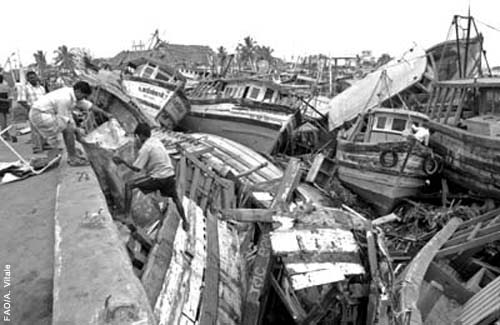
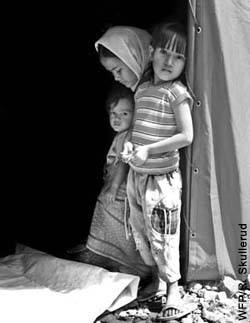
IFAD's immediate response to the tsunami was to commit to mobilize US$100 million to support post-emergency recovery in affected areas of India, Indonesia, the Maldives and Sri Lanka.
To date, IFAD has provided US$33.6 million in interest-free loans from its own resources to meet post-tsunami programme costs. Grants are being sought from cofinancing partners to cover the total cost of rehabilitation and recovery programmes. This includes US$30 million in grants needed to get a recovery programme underway in Aceh, Indonesia. This six-year programme, designed in partnership with affected communities, the provincial government of Aceh and the Ministry of Agriculture, will support reconstruction of approximately 250 villages.
In Indonesia, IFAD extended the area of the Income-Generating Project for Marginal Farmers and Landless (Phase III) and reallocated US$3.2 million from the project's funds to finance the rehabilitation of livelihoods in the worst-affected rural districts of the provinces of Aceh and North Sumatra.
In India, the US$68.7 million Post-Tsunami Sustainable Livelihoods Programme for the Coastal Communities of Tamil Nadu will directly benefit about 140,000 households in 200 coastal villages affected by the tsunami. IFAD will provide a US$15 million loan and a total of US$38.8 million has so far been provided by partners in the country, including banks, microfinance institutions and the Government.
In Maldives, the US$5.0 million Post-Tsunami Agricultural and Fisheries Rehabilitation Programme will focus on restoring the fisheries and agriculture sectors. IFAD is providing an initial US$2.0 million loan and a US$200,000 grant for the programme, and is committed to mobilizing another US$2.1 million loan. The programme will provide more than 8,000 fishers and 20,000 small farmers with tools, equipment and facilities, so they can re-establish their productive activities. A new agricultural produce market will be built in the capital, Malé, to help establish marketing channels for producers on small islands.
Two new programmes have been approved for Sri Lanka: the U$4.7 million Post-Tsunami Livelihoods Support and Partnership Programme, and the US$33.5 million Post-Tsunami Coastal Rehabilitation and Resource Management Programme. IFAD loans worth a total of US$16.6 million have been approved for the programmes, and the Fund is committed to mobilizing two other loans for the same amount. The first programme will support rapid rehabilitation and development of essential infrastructure, including housing and social and community buildings, while the second is a more comprehensive medium-term recovery programme for coastal communities.
The Italian Government will provide approximately US$2.0 million for the programmes in Sri Lanka and Maldives.
IFAD has also mobilized more than US$7.0 million from the Global Environment Facility to restore and conserve the coastal ecosystem in Sri Lanka.
FAO's Investment Centre assisted IFAD in responding to the tsunami disaster in both the Maldives and Sri Lanka. An Investment Centre team designed Post Tsunami Agricultural and Fisheries Rehabilitation Programme for the Maldives.
In Sri Lanka, IFAD and FAO worked together on policy studies on land tenure, gender and land, and on managing land conflicts, which contributed to the design of the Post-Tsunami Livelihood Support and Partnership Programme.
